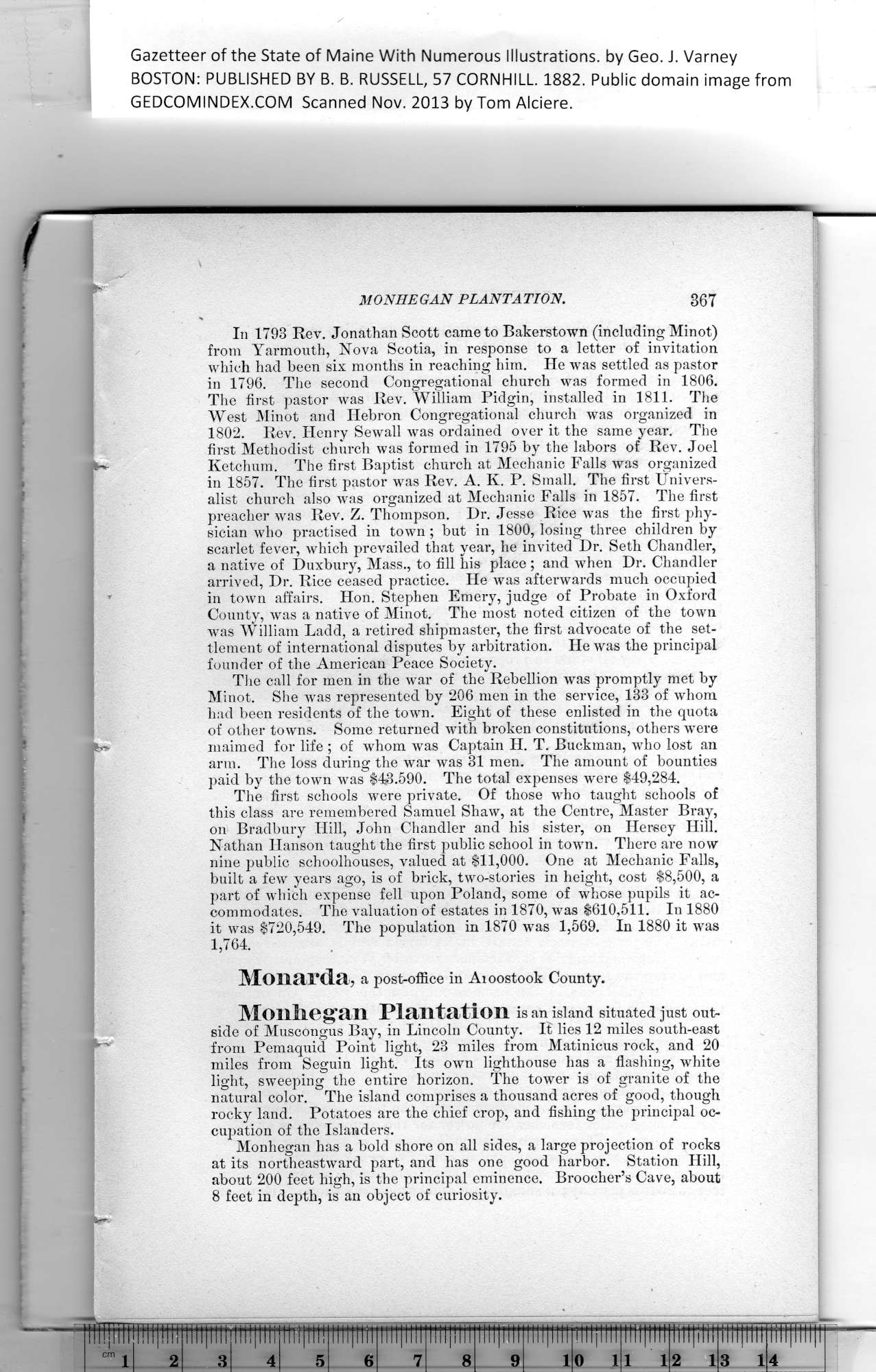|
Gazetteer of the State of Maine With Numerous Illustrations, by Geo. J. Varney
BOSTON: PUBLISHED BY B. B. RUSSELL, 57 CORNHILL. 1882. Public domain image from
MoNHEGAN PLANTATION. 367
In 1793 Rev. Jonathan Scott came to Bakerstown (including Minot)
from Yarmouth, Nova Scotia, in response to a letter of invitation
which had been six months in reaching him. He was settled as pastor
in 1796. The second Congregational church was formed in 1806.
The first pastor was Rev. William Pidgin, installed in 1811. The
West Minot and Hebron Congregational church was organized in
1802. Rev. Henry Sewall was ordained over it the same year. The
first Methodist church was formed in 1795 by the labors of Rev. Joel
1 k-*- Ketchum. The first Baptist church at Mechanic Falls was organized
in 1857. The first pastor was Rev. A. K. P. Small. The first Univers-
alist church also was organized at Mechanic Falls in 1857. The first
preacher was Rev. Z. Thompson. Dr. Jesse Rice was the first phy-
sician who practised in town; but in 1800, losing three children by
scarlet fever, which prevailed that year, he invited Dr. Seth Chandler,
a native of Duxbury, Mass., to fill his place ; and when Dr. Chandler
arrived, Dr. Rice ceased practice. He was afterwards much occupied
r in town affairs. Hon. Stephen Emery, judge of Probate in Oxford
■ County, was a native of Minot. The most noted citizen of the town
was William Ladd, a retired shipmaster, the first advocate of the set-
tlement of international disputes by arbitration. He was the principal
founder of the American Peace Society.
The call for men in the war of the Rebellion was promptly met by
Minot. She was represented by 206 men in the service, 133 of whom
had been residents of the town. Eight of these enlisted in the quota
of other towns. Some returned wflth broken constitutions, others wrere
maimed for life ; of whom was Captain H. T. Buckman, who lost an
arm. The loss during the war was 31 men. The amount of bounties
paid by the town was $43,590. The total expenses were $49,284.
The first schools were private. Of those who taught schools of
this class are remembered Samuel Shaw, at the Centre, Master Bray,
on Bradbury Hill, John Chandler and his sister, on Hersey Hill.
Nathan Hanson taught the first public school in town. There are now
nine public schoolhouses, valued at $11,000. One at Mechanic Falls,
built a few years ago, is of brick, two-stories in height, cost $8,500, a
part of which expense fell upon Poland, some of whose pupils it ac-
commodates. The valuation of estates in 1870, was $610,511. In 1880
it was $720,549. The population in 1870 was 1,569. In 1880 it was
1,764.
]\Lonai*Cla, a post-office in Aioostook County.
Monlieg’an Plantation is n island situated just out-
side of Muscongus Bay, in Lincoln County. I£ lies 12 miles south-east
^ from Pemaquid Point light, 23 miles from Matinicus rock, and 20
miles from Seguin light. Its own lighthouse has a flashing, white
light, sweeping the entire horizon. The tower is of granite of the
natural color. The island comprises a thousand acres of good, though
rocky land. Potatoes are the chief crop, and fishing the principal oc-
cupation of the Islanders.
Monhegan has a bold shore on all sides, a large projection of rocks
at its northeastward part, and has one good harbor. Station Hill,
I about 200 feet high, is the principal eminence. Broocher’s Cave, about
8 feet in depth, is an object of curiosity.
PREVIOUS PAGE ... NEXT PAGE
This page was written in HTML using a program written in Python 3.2
|
